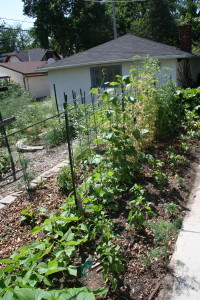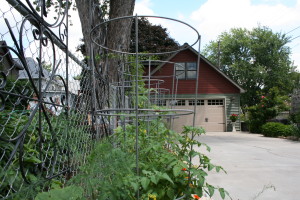Day 2: Where to Put Your Vegetable Garden

Vegetables want to grow — remember that when things don’t seem to be going right in your new vegetable garden — they want to produce fruit, to pass on their genetic code. They want things to work out for you.
To grow, vegetables need just a few things: good soil to provide nutrients, sunlight and water. To grow well, air circulation also helps as does an environment rich with beneficial insects and not too rich with those that prey on your plants. Having the vegetables in a convenient spot so you will visit them with water and harvest their fruits is also a good idea. In deciding where to put your garden, the first three are the important considerations.
Soil. The best soil for vegetables should be rich in organic matter and drain easily. If you are planting in the ground, the soil should look dark, chocolatey brown in color and be alive with worms and other organisms. When you squeeze a handful of the soil, it should hold together but not tightly. Water should drain through it, but not so fast that the plants will not have time to soak it up. You can do a soil test to find out what the soil needs, though most soil problems are solved by diligent application of compost. If you have questions about the safety of the soil, use raised beds or other containers and a prepared soil mix. For a basic discussion of soil, the University of Minnesota has this website.
 Sun. To grow best, vegetables need at least 6 hours of sunlight per day. When deciding where to put your vegetable garden, watch the sun move across the sky and see which areas of your yard get light during which parts of the day. Lettuce, chard and other greens can often get by with less light, but tomatoes, green beans and other fruiting plants like as much sun as they can get. If your sunniest spot is in the front yard, consider using containers to grow some vegetables. (See tomorrow’s post for more on containers and raised beds.)
Sun. To grow best, vegetables need at least 6 hours of sunlight per day. When deciding where to put your vegetable garden, watch the sun move across the sky and see which areas of your yard get light during which parts of the day. Lettuce, chard and other greens can often get by with less light, but tomatoes, green beans and other fruiting plants like as much sun as they can get. If your sunniest spot is in the front yard, consider using containers to grow some vegetables. (See tomorrow’s post for more on containers and raised beds.)

Water. Vegetables need about 1 inch of water per week or a little more, if it is very hot. To measure how much Mother Nature is providing, set a simple rain gauge in the garden. If a week is dry, supplement rainfall with water from the hose. When deciding where to put your vegetable garden, consider the distance from your outdoor faucet. Avid gardeners will often install drip irrigation in their vegetable gardens, but for most small gardens a hose works fine. Like other plants, it’s best to water the ground around the plants rather than the leaves and, if it works with your schedule, water in the morning rather than at night. One thing to remember about watering is that consistency is as important as amount. Tomatoes, especially, are sensitive to dry periods, so keep the water coming. Plus, watering the garden is a quiet, enjoyable activity. Give yourself a break and grab the hose.
Convenience. When deciding where to put your vegetables, another factor is convenience. If you have a sunny spot near the kitchen door, so you can run out to snip herbs or harvest a few beans for dinner, that’s the place to put the garden. Otherwise, consider other spots in your yard that you like to visit. You want to have a vegetable garden in a place where you will use and enjoy it most.
Follow Notes from Northern Gardener throughout January as we offer our series on 31 Days to a Great Northern Vegetable Garden. Tomorrow: Pots vs. Raised Beds vs. Traditional Beds.
